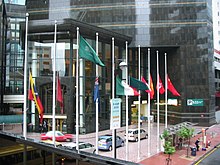Mourning flags

In mourning flags , flags are not completely set to express mourning . Mourning flags can be used, for example, in the event of the death of important state figures or as a reminder of high-profile events with death consequences such B. the terrorist attacks of September 11, 2001 are ordered.
In Germany it is ordered by the federal or state interior ministers . In Germany, on the day of commemoration of the victims of National Socialism and on the day of national mourning, the flags are raised at half-mast.
In Austria, it can be prescribed nationwide by the Federal Chancellor or nationwide by the Governor.
execution

The mourning flag is usually carried out in the form of half-mast or half -mast flagging (" Halbstock flag" / "Halbstocks the flag!") In this case, the respective flags - but not the banners - on public buildings are not on top of the flagpole, but (depending Length of the flag) positioned slightly above the center of the mast. The correct hoisting of the flag at half-mast takes place in such a way that it is first pulled to the top of the mast and only then is lowered to the half-mast position. Conversely, the acceptance takes place in such a way that the flag is first pulled all the way up again and only then removed.
If the flags at half-mast not possible, then at the flag crape to install and flags the flag up the pole.
history
The origin of the half-mast flagging lies in the sea battles with sailing ships. It was not only the flag of the defeated ship that was brought down, but also the top sail first. The enemy later had to half haul his own flag and in its place the flag of the winner was set as a visible sign for all.
This ritual later gave rise to the custom of pulling up a flag as a sign of respect for high-ranking personalities. Ships also greeted each other by lowering ( dipping ) the flag. The original purpose of freeing up space for another flag has been forgotten. Today the half-mast flag is a sign of respect for the dead.
particularities

The only flags that are never hoisted at half mast are the flag of Saudi Arabia , the flag of Iran , the flag of Iraq , the flag of Somaliland and the Royal Standard .
This does not happen with the flags of Saudi Arabia, Iran and Somaliland, because with the Shahāda ( Saudi Arabia , Somaliland ) and the Takbīr ( Iran ) Islamic creeds can be read on the flag.
With the Royal Standard it doesn't happen because formally the head of state (King or Queen of Great Britain) is never dead. If the regent dies, the rightful heir to the throne takes his place immediately (" The king is dead, long live the king ").
In the case of the Iranian flag, a black flag is placed on a second mast as an expression of mourning, if possible.
In Austria , on non-governmental occasions, raising monochrome black flags to the top of the mast is widespread, for example for a day to a week in the event of the death of a school or company member or a member of the ÖKB or the volunteer fire service.
The flag of the unity of the Federal Republic of Germany on the Republic Square in Berlin is, with rare exceptions, not raised at half mast.
Some national flags are set at half mast on Good Friday , such as the flag of Malta and the flag of the Faroe Islands .
Web links
- Flag and flag labels of the Austrian flag
Individual evidence
- ^ Werner Rüdenberg, Hans OH Stange: Chinese-German dictionary . Cram, De Gruyter & Co., Hamburg 1963, ISBN 3-11-003548-0 , p. 319, bottom right (半 旗)
- ^ Werner Rüdenberg, Hans OH Stange: Chinese-German dictionary. Cram, De Gruyter & Co., Hamburg 1963, ISBN 3-11-003548-0 , p. 319, right column, last combination of characters
- ↑ Half-stick the flag! by Dr. Siegfried Toeche Mittler, Berlin 1922
- ↑ flagging on www.protokoll-inland.de , accessed on August 16, 2017